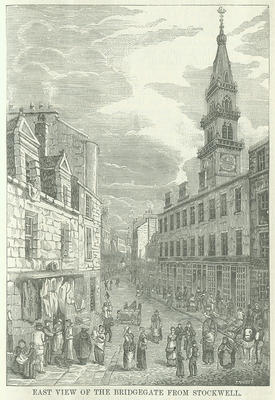
View of the Bridgegate and the Merchants' House looking east from Stockwell Street c 1849.
The Bridgegate (or "Briggait") was originally lined with the mansions of rich Glasgow merchants but by the mid-19th century it was occupied predominantly by Irish immigrants and their businesses. According to J F S Gordon, writing in the early 1870s, there were many Irish lodging houses on the street. An hotel, the "Londonderry", had a predominantly Protestant Irish clientele while "The Emerald Isle" tavern catered mostly for Catholics.
An Old Clothes Market was established in Scanlon's Close off Bridgegate in 1824, the forerunner of "Paddy's Market". The trade was a profitable one and Bridgegate was soon lined with shops, booths and barrows belonging to dealers in second-hand clothes. Much of the old clothing was purchased for export to Ireland. Gordon also noted that the street was renowned "for the quality of its tripe, potted meat and cow heel" and for its public houses, but notorious for brawling and Saturday-night rioting.
Reference: Mitchell Library, GC 941.435 GOR
Reproduced with the permission of Glasgow City Council, Libraries Information and Learning
Keywords:
closes, drinking, horses and carts, hotels, immigration, Irish immigrants, Merchants' House, Merchants' Steeple, Old Clothes Market, Paddy's Market, public houses, pubs, Roman Catholics, second-hand clothes shops, second-hand clothes trade, soldiers, steeples, streetscenes, taverns, The Emerald Isle, The Londonderry, Ulster Protestants
You have 80 images in your photo album.